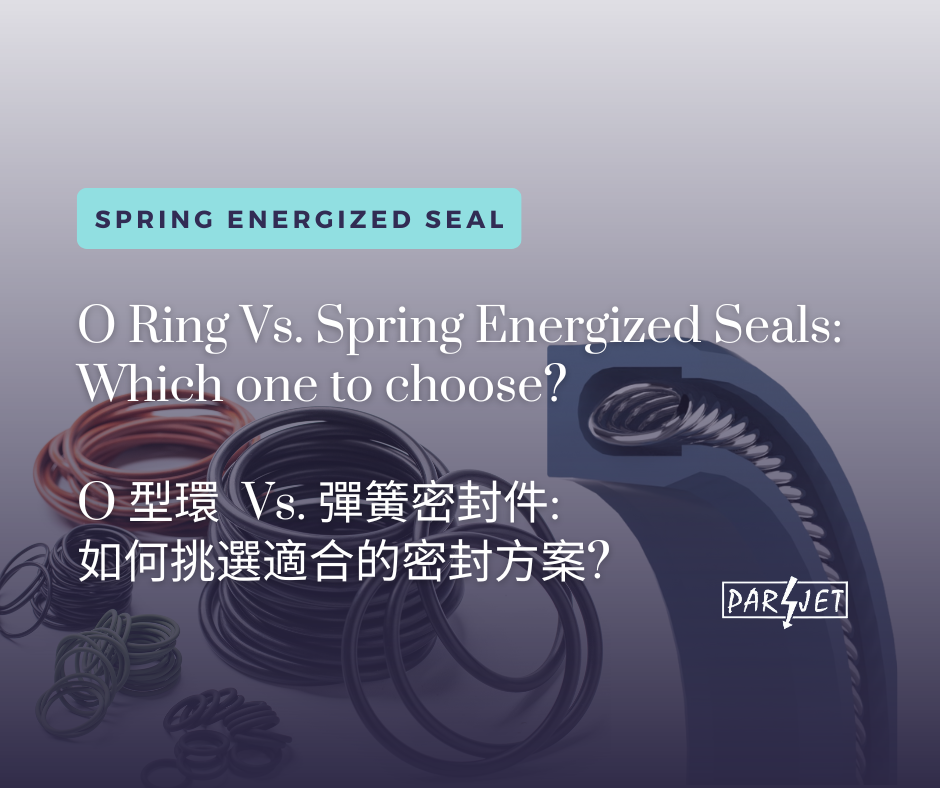O Rings Vs. Spring Energized Seals
There are many types of sealing solutions out there, from simple O – Rings, X Rings, Back Up Rings to more complicated mechanical seals, PTFE Lip Seals, Spring Energized Seals. Each type of sealing element has its own benefits and weakness. In this article, we will compare the difference between O Rings and Spring Energized Seals. To provide a comprehensive comparison analysis, it involves evaluating various factors, including sealing mechanism, performance in different environments, materials, pressure and temperature capabilities, cost considerations… and more.
1. Sealing Mechanism:
O - Rings:
Mechanism: O-rings create a seal through deformation, relying on the compressive force between the ring and the mating surfaces.
Flexibility:
- • Great elasticity which can be used without any energizer.
- • Good flexibility and adaptability to irregular shapes
Spring-Energized Seals:
Mechanism: Due to the inflexibility of PTFE materials, the PTFE seal jacket requires an energizer, often springs, such as cantilever springs, canted coil springs, helical springs. It utilizes the spring energizer to provide additional force for the sealing lip for a more robust seal.
Flexibility:
- • Greater adaptability due to the dynamic nature of the spring-energized design
2. Performance in Different Environments:
O - Rings:
- • Strengths: Effective in standard conditions and static applications.
- • Weaknesses: May degrade in extreme temperatures, abrasive working conditions or dynamic applications
Spring-Energized Seals:
- • Strengths: Designed for challenging environments, provides better mechanical properties to resist temperature variations, chemicals, and dynamic movements.
- • Weaknesses: Can be over-engineered for simpler applications, resulting in higher costs.
3. Materials and Compatibility:
O - Rings:
- • Materials: Typically made of elastomers (Nitrile, Viton, Silicone).
- • Compatibility: Limited chemical compatibility in some cases.
Spring-Energized Seals:
- • Materials: Commonly made from PTFE (polytetrafluoroethylene) and other polymers like PEEK, UHMW-PE. Other fillers can be used to change the properties of the seals, for instance, carbon fiber, glass fiber or bronze.
- • Compatibility: Provide wide range of chemical compatibility.
4. Pressure and Temperature Capabilities:
O - Rings: Suitable for moderate pressure and temperature conditions.
Spring-Energized Seals: Engineered for a wider range of pressures and temperatures, including cyclical changes in pressures and temperatures which make them suitable for more demanding applications.
5. Coefficient of friction
O - Rings: Higher coefficient of friction, some requires lubrication film under certain conditions
Spring-Energized Seals: PTFE has a low coefficient of friction; it has three times lower compared to O Rings. It has self-lubrication and non-stick characteristics and can withstand higher speed.
6. Dynamic Sealing:
O - Rings: Effective in static applications, less suitable for dynamic conditions
Spring-Energized Seals: suitable for dynamic sealing, providing better performance in situations involving movement or vibration, such as rotary and reciprocating
7. Cost Considerations:
O - Rings: Lower costs; More cost-effective than spring-energized seals.
Spring-Energized Seals: Can be more expensive but the given benefits from the enhanced performance can compensate for the higher cost in demanding applications.
8. Applications and Industries:
O - Rings:
- • Common Applications: Widely used in static sealing applications where cost is a significant factor.
- • Industries: General industrial applications, automotive, water systems
Spring-Energized Seals:
- • Common Applications: Critical applications where surviving in challenging conditions is crucial
- • Industries: Aerospace, oil and gas, military, food processing, semiconductor
Overall, O Rings are suitable for simple static applications with moderate pressure and temperature conditions. They are cost effective and do not require many engineering designs. Spring Energized Seals are, on the other hand, more suitable for demanding applications that involve aggressive working conditions, extreme temperature and pressure, high speed, and low lubrication environment. It has a higher cost compared to O rings but the enhanced sealing performance may justify the price.
Parjet offers both O Rings and Spring Energized Seals (HiPerSeal®), if you have any inquiries, please contact us here.






